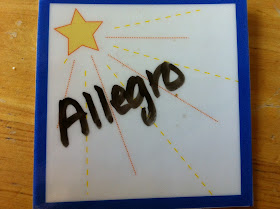Some of you may know, but most of you don't, but I'm having a BABY! What does that mean? It means that I've been sick for a month now and not feeling up to doing much of anything....including practicing. I'm sure my daughter doesn't mind, but in the back of my mind, I feel like a hypocrite for having a blog all about practicing when I'm not practicing what I preach...at least not lately. I WILL get back into the routine again sometime soon.
I've spent some time adding practicing charts to the website I've had stored on my computer for months. So, if you go to The Practice Shoppe website and browse around you may find some new, helpful charts. Here is a game I found that I used a while back with my little one. It's a basic chart, so you could make up your own rules.
 One way: fill in the boxes with songs that need to be practiced and just start from the beginning and use some sort of marker (these fun erasers work wonders) and proceed one box at a time until you get to the end. I let my daughter choose what to play on the butterflies.
One way: fill in the boxes with songs that need to be practiced and just start from the beginning and use some sort of marker (these fun erasers work wonders) and proceed one box at a time until you get to the end. I let my daughter choose what to play on the butterflies.Another way: fill in the boxes with songs that need to be practiced and make some cards with ways to move across the board (move forward two spaces, move back 3 spaces.) Include other fun cards (give a kiss to mom, play the next song outside, etc.)
Like I said - simple....we moms don't have time for anything too elaborate. But perhaps this will put some spice into your practice this week. I think I may use it again.
Find this chart HERE!


















 Right at the front of the book, I put the calendar for the whole year through next August. I'm going to use this calendar to put her violin dates (since my calendar is full of our family's activities) so she can see for herself when she has lessons and group lessons. As a kindergartener this year she will be learning a lot about calendars. We will also put a sticker on each day that she practices so she'll have a visual of how much she practices
Right at the front of the book, I put the calendar for the whole year through next August. I'm going to use this calendar to put her violin dates (since my calendar is full of our family's activities) so she can see for herself when she has lessons and group lessons. As a kindergartener this year she will be learning a lot about calendars. We will also put a sticker on each day that she practices so she'll have a visual of how much she practices


 After the Book 1 review chart are a variety of other charts just for fun in case we want to use them. This is one reason I was debating whether or not to bind this or put it in a 3 ring binder. I know that we will want to use other charts throughout the year. But I liked the idea of a spiral-bound book because it will all stay together and it will be easy to fold back so it'll fit on my lap or my stand easier.
After the Book 1 review chart are a variety of other charts just for fun in case we want to use them. This is one reason I was debating whether or not to bind this or put it in a 3 ring binder. I know that we will want to use other charts throughout the year. But I liked the idea of a spiral-bound book because it will all stay together and it will be easy to fold back so it'll fit on my lap or my stand easier.

















